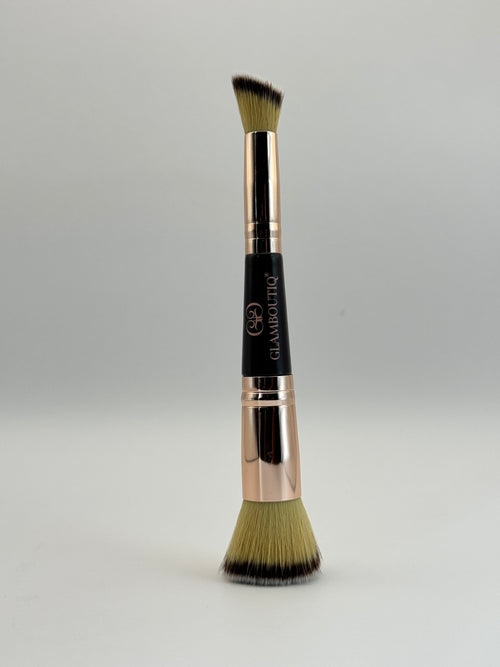Foundation is key to creating a smooth, flawless makeup look. Whether you’re heading out for a casual day or a special event, learning how to apply foundation? Not only does it enhance your natural beauty, it also helps cover imperfections, balance your skin tone, and create the perfect base for other makeup products like blush and contour.
Either way, the good news is that applying foundation doesn’t have to be complicated! With the right products, tools, and techniques, anyone can achieve a radiant, natural-looking finish. Prepping your skin properly, choosing the right shade, and blending seamlessly are essential steps to getting it just right.
In this guide, we break the entire process down into simple, easy-to-follow steps. Whether you’re a beginner or just looking to fine-tune your routine, you’ll learn everything from how to prep your skin to how to avoid common mistakes like streaking or clumping. Let’s get started!
What is the importance of foundation in makeup?
Foundation is one of the most important steps in any makeup routine. Its primary purpose is to create a smooth, even base for the rest of your makeup. By covering imperfections like uneven skin tone, blemishes, or redness, foundation helps your skin look flawless and radiant. It acts as a blank canvas, allowing other makeup products like blush, eye shadow, and lipstick to stand out and complement each other.
Using foundation also helps to enhance your natural beauty by enhancing your complexion without looking overdone. A well-matched foundation gives your face a uniform look and adds confidence to your appearance. For a natural daytime look or a glamorous evening style, foundation ensures that your makeup stays consistent and polished.
Another important benefit of foundation is its protective layer. Many modern formulas contain SPF, which protects your skin from harmful UV rays. Some foundations are also enriched with skincare ingredients that hydrate your skin or protect it from environmental damage, making them both makeup and skincare in one.
However, choosing the right foundation is essential. A shade that matches your skin tone and a formula that suits your skin type makes all the difference. Lightweight formulas are great for natural looks, while full-coverage options are ideal for special occasions or when you need extra coverage.
If you’re looking for a foundation that’s suitable for mature skin, check out our blog post on How to Choose the Perfect Foundation for Mature Skin . Here you’ll find expert tips on how to choose the ideal product for your needs.
So foundation is the backbone of your makeup routine. It creates an even surface, enhances your overall look and provides extra protection for your skin.
How do you apply foundation?
How to Apply Foundation? Applying foundation is an essential step in creating a flawless makeup look. It evens out your skin tone, hides imperfections, and sets the base for the rest of your makeup. Follow these detailed steps to ensure your foundation looks natural, smooth, and long-lasting.
Prepping your skin is the first and most important step to achieving a smooth and long-lasting foundation look. Skipping this step can lead to uneven texture, patchiness or clumpiness.
1. Prepare your skin
Cleanse your skin
- Why it's important: Cleansing removes dirt, oil, and makeup residue, allowing your foundation to adhere to clean skin. This prevents clogged pores and helps your makeup look fresher.
- How to do it: Use a gentle cleanser that is suitable for your skin type. Avoid harsh cleansers that strip away natural oils, as they can dry out your skin or cause excess oil production.
Exfoliate (optional)
- Why it's important: Exfoliating removes dead skin cells that can make your foundation look uneven or flaky. This step is especially helpful if you have dry or rough patches.
- How to do it: Use a gentle exfoliant or a chemical exfoliant with ingredients like glycolic or lactic acid once or twice a week. Be careful: Over-exfoliating can irritate your skin.
Hydrate your skin
- Why it's important: Moisturizer hydrates your skin and provides a smooth base for foundation. It also helps foundation blend better and prevents it from sticking to dry patches.
- How to choose:
- For oily skin, choose an oil-free or mattifying moisturizer to reduce shine.
- for dry skin a rich, hydrating formula to keep your skin nourished.
- For combination skin, you can apply different moisturizers to specific areas (light moisturizers for oily areas, hydrating moisturizers for dry areas).
- How to Apply: Apply a small amount of moisturizer evenly to your face, focusing on areas prone to dryness, such as around the nose or cheeks. Allow to absorb completely before moving on to the next step.
Prepare your skin
- Why it’s important: Primer acts as a barrier between your skin and makeup, filling in pores, evening out texture, and helping your foundation last longer. It also enhances the finish, whether it’s matte or dewy, depending on the type of primer.
- How to choose:
- For oily skin, choose a mattifying primer that controls shine and minimizes the appearance of pores.
- For dry skin, choose a hydrating primer that adds moisture and prevents foundation from settling into fine lines.
- For sensitive skin, it is best to use primers with soothing ingredients, such as aloe vera or chamomile.
- How to Apply: Take a pea-sized amount of primer and spread it evenly over your face with your fingers. Concentrate on areas where your makeup tends to fade or where pores are more visible, such as the T-zone.
2. Choose the right foundation
- Skin type matters: For oily skin, choose matte or oil-free formulas. For dry skin, choose hydrating or dewy foundations. Combination skin benefits from a balanced formula.
- Shade Matching: Test foundation shades on your jawline or wrist to make sure they match your natural skin tone. Avoid shades that are too light or too dark.
3. Use the right tools
- Brush: Use a thick foundation brush for full coverage and a smooth, polished look.
- Sponge: A damp makeup sponge ensures an even distribution of the foundation and provides a natural finish.
- Fingers: Use your fingers for quick and easy application, especially with light foundations.
4. Apply in small amounts
- Apply a pea-sized amount of foundation to the back of your hand.
- Apply foundation to your forehead, nose, cheeks and chin. Start small, you can always add more if needed.
5. Mix evenly
- Work Outwards: Blend the foundation from the center of your face outwards. Use circular motions with a brush or a dabbing motion with a sponge.
- Cover key areas: Don't forget to blend the jawline, hairline and neck to avoid a 'mask' effect.
6. Set your foundation
- Setting Powder: Apply a thin layer of transparent setting powder to your face to set the foundation.
- Setting Spray: Finish with a setting spray for extra long-lasting results and a natural glow.
7. Add additional coverage if needed
- If you suffer from blemishes or imperfections, apply a small amount of concealer after your foundation and blend gently.
8. Complete your makeup look
- Once your foundation is applied, you can move on to the rest of your makeup, such as blush, bronzer, eyeshadow and lipstick.
9. Update during the day
- Use blotting papers to absorb excess oil or a pressed powder to quickly touch up your foundation and keep it looking fresh.
How to Apply Foundation? By following these steps and tips, you can achieve a flawless foundation look that stays put all day long.
Should you apply foundation all over your face?
How to Apply Foundation Applying foundation doesn’t necessarily mean covering your entire face. The key to a natural, flawless look is to apply foundation where you need it most. Here’s how to determine whether you should apply it all over or just in specific areas:
Understand your skin's needs
If you have an even skin tone with just a few spots or redness, you don’t need to apply foundation everywhere. Focus on the areas that need coverage, like around the nose, chin, or other spots you want to conceal. This approach will help maintain a more natural look.
The case for full coverage
For those with uneven skin tone, acne, scarring, or pigmentation all over the face, it may be a better option to apply foundation all over. This will create an even base and even out imperfections. However, use a lightweight formula and build coverage gradually to avoid a cakey look.
Less is more
Even if you apply foundation all over your face, you don't need a thick layer. Use a small amount and blend it evenly with a brush, sponge or your fingers. The goal is to enhance your natural beauty, not to mask it.
Spot Concealing as an alternative
For a minimalist approach, try spot concealing. After applying foundation, use concealer on key areas to cover specific blemishes or dark spots. This method reduces the amount of product on your skin while still giving you a polished look.
Adapt for different occasions
For everyday makeup, applying foundation only to problem areas can save time and look more natural. For special occasions or professional events, opt for a full face application for a more polished look.
Whether you choose to apply it all over your face or for a targeted application, make sure to always blend your foundation well and set it with powder or setting spray to help it stay put longer.
What common mistakes should you avoid?
How to Apply Foundation Applying foundation may seem simple, but a few common mistakes can make your makeup look less natural or affect how long it lasts. Here’s a guide to help you avoid these pitfalls and achieve a flawless finish:
1. Skipping skin prep
Applying foundation to unprepared skin can lead to blotchiness or uneven coverage. Always cleanse, moisturize, and prime your skin before applying foundation. This creates a smooth canvas and helps the foundation stay in place.
2. Using the wrong shade
Choosing a foundation that is too light or too dark is a common mistake. Always test the shade on your jawline, not your hand or wrist, to ensure it matches your natural skin tone. The goal is a seamless blend that looks like your skin, not a mask.
3. Applying too much product
Using too much foundation can result in a cakey, heavy look. Start with a small amount and gradually build up coverage as needed. It's easier to add more than to remove excess.
4. Forgetting to blend properly
Blending is key to a natural finish. Unbleached foundation can leave streaks or visible lines, especially around the hairline, jawline and ears. Use a sponge, brush or fingers to blend the foundation evenly and outwards from the center of your face.
5. Neglecting the neck and hairline
By stopping your foundation at your jawline, you create a clear line between your face and neck. Always blend foundation into your neck and hairline for a consistent and natural look.
6. Not laying your foundation
Skipping a setting powder or spray can cause your foundation to smudge, fade, or look shiny. Set your foundation with a powder for a matte finish or a spray for a dewy finish to ensure it stays put all day.
7. Using the wrong tools
Different tools will give you different results. A brush will give you fuller coverage, a sponge will give you a smooth blend, and fingers work well for a light application. Choose a tool that suits your desired look and take your time to blend thoroughly.
8. Ignoring your skin type
Using a foundation formula that doesn't suit your skin type can lead to problems like dry, oily skin or breakouts.
- For oily skin, choose an oil-free or matte foundation.
- For dry skin, choose hydrating or dewy formulas.
- For combination skin, use products that balance your skin's needs.
9. Overlooking oxidation
Some foundations can darken after application, a process called oxidation. To avoid this, test the product on your skin and wait a few minutes to see how it reacts before purchasing.
10. Rushing the process
Applying foundation quickly without attention to detail often results in uneven coverage. Take your time to blend and build coverage where needed for a polished look.
So, by avoiding these common mistakes, you will achieve a flawless and natural foundation finish. Remember, practice makes perfect!
How do you set your foundation so that it lasts long?
Setting your foundation is essential for ensuring that your makeup stays fresh, smooth, and in place all day long. After applying your foundation, start by using a setting powder or translucent powder. Using a fluffy brush or powder puff, lightly dust your face, focusing on areas prone to oiliness, such as your forehead, nose, and chin. This step will help absorb excess oil and prevent your foundation from creasing or running.
For extra hold, follow with a setting spray. Hold the spray about 8-10 inches from your face and spray evenly in a light, sweeping motion. Setting sprays not only set your foundation, but can also enhance your desired finish, whether you prefer a matte or dewy look.
In any case, if you have oily skin, use a mattifying powder to control shine, while those with dry skin can opt for hydrating sprays to keep makeup comfortable and fresh. Remember, it’s important to use these products sparingly: too much powder or spray can weigh down your makeup.
When you apply your foundation correctly, you'll enjoy a long-lasting, even result that requires minimal touch-ups throughout the day.
Last few words
Mastering the art of foundation application is essential for achieving a flawless makeup look. The key steps—prepping your skin, selecting the right foundation, and blending it properly—can make all the difference. Start by cleansing, moisturizing, and priming your skin to create a smooth base. Choose a foundation that matches your skin tone and complements your skin type, whether it’s oily, dry, or combination.
Application is just as important as the product itself, though. Use the tool that works best for you, whether it’s a sponge for seamless blending, a brush for polished coverage, or your fingers for quick application. Start with small amounts and gradually build coverage as needed to avoid a heavy, unnatural finish.
That’s why blending is key to achieving a natural look. Focus on areas like your hairline, jawline, and neck to avoid visible lines. Finally, set your foundation with a powder or setting spray to keep it in place and ensure it stays put all day.
Following these simple yet effective steps for applying foundation will enhance your natural beauty and give you a radiant, long-lasting look.


